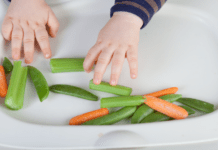A few months ago, I truly, honestly didn’t think my son would EVER be potty trained.
I’d been “trying” to train him for months (and months), and all I had to show for it was a handful of wasted Saturdays, a few horrifying freeze-frames of poop on the floor in my mind, and (the worst) a kid who literally screamed at the mention of the word potty.
He was pushing 3 and a half, and had yet to officially “show interest” in the potty. Honestly, he couldn’t have cared less about that dumb thing, or who else was using it, or whether he was a big boy or a baby. He was mildly interested in his sweet new superhero underwear—but actually wearing it? Pass.
When people said “well, he won’t go to college in diapers!” I wasn’t even comforted, because: ya sure about that?
And then, one random day, everything changed.
We were at Barnes and Noble, heading toward the kids’ section to accost the train table, when we passed the child development section. Usually, on B&N trips, I try to swipe a book somewhere along the route from the door to the train table—just something for me to thumb through while the kids play. On that day, a potty training book happened to be face-out, and the title caught my eye: “Oh CRAP! Potty Training: Everything Modern Parents Need to Know to Do It Once and Do It Right.”
Now, honestly, I could stop this article right here and just say: if you’re potty training, or approaching it, GO BUY THIS BOOK IMMEDIATELY.
(Seriously. It is a brilliant piece of literature. And before you ask the question I originally asked—“a whole entire book on potty training??”—yes, a whole book, and every single word is a completely necessary golden nugget of wisdom.)
…BUT since you took to the time to read this article, and were probably hoping for some sort of helpful information, I’ll try to share some cliffs notes.
One of the first things the author, Jamie Glowacki, taught me was this:
The secret to potty training is YOU.
And she goes on… “You, you, you, you, you, you. YOU are the parent. YOU provide safety and boundaries for your child. YOU are the teacher.”
She talks about how potty training is the first thing we really teach our children. That most milestones before that—crawling, walking, talking—happen more or less instinctually, and will usually happen without any direct guidance from parents. So when we’re used to our kids just naturally picking things up, it makes sense that our first instinct is to take a passive “he’ll figure it out” approach to potty training.
WHOOPS.
It was honestly the first time anyone had suggested that potty training was MY commitment, as the parent, rather than another magical milestone my son would hit on the elusive day when he became “ready.”
Jamie was also the first person to suggest that potty training was about anything more than saving money on diapers. “Self-esteem comes from mastering a task, from gaining dignity and self-respect,” she says. “Potty training is a way you can give this to your child.” She told a scary story about a poor, embarrassed 6-year-old going to a sleepover with Pull-ups, and I was sold.
So I absorbed all this in the five minutes I distractedly flipped through the book at Barnes & Noble, and afterwards, I was a changed woman. I bought the book and went home on a MISSION.
Now, let’s talk strategy. Jamie divides the whole potty training process into 5-6 “blocks”:
- Block one: naked training
- Block two: commando training
- Block three: going in different situations (out of the house)
- Bock four: underwear training
- Block five: consistent self-initiation
- Block six: night and nap training (optional—we actually did it all in one shebang on day 1, and it worked surprisingly well!)
She gives very good reasons for doing each of these blocks, in this order, and very clear instructions for how to know when to progress from one to the next. (I was intrigued to learn that underwear feels almost as safe and cozy as a diaper, so it’s really helpful to put off introducing it until kids are pretty far into the process. WHOOPS #2.)
Within two days, I’d read the whole book, and had a running list in my head of all the things I’d been doing “wrong.” (I use quotes because I know you can be successful without avoiding everything on this list, and plenty of people have. By “wrong,” I mean: personally, I think I could have gotten quicker, better results without these things.)
Mistake 1: Too Much Pressure/Lack of Parental Chillness
So I thought I was doing ok with this. I was saying the right things, keeping it casual.
But this book showed me that my nonverbal behaviors were speaking louder than my words. When I was covering the living room with towels, that said to my son “I don’t trust you,” which flew in the face of what I was actually saying: “You can do this!”
Eagle-eyeing him all day and asking him if he needed to go potty every five seconds wasn’t helping either. Plus, I’m sure he could pick up on the INTENSE anxiety I felt all day, while waiting for bodily fluids to pour out onto my (NEW) carpeting at some random time…
“Your energy, your vibe, your nonverbal cues are leading the show here,” Jamie says in the book. “Be sure and be steady.”
(The tricky part, of course, is figuring out how to be firm and rigid in your approach—since kids respond well to consistency—but super relaxed in your attitude. NOT easy!)
Mistake 2: Waiting Until He’s “Ready”
Most potty training articles cite this as tip #1. All I’d ever heard was that if I tried to potty train my son before he was ready, it would be an epic failure.
And so, at the first sign of friction, I would throw up the “not ready” card and back down.
Finally (with Jamie’s help), I realized that I’d been a little too consumed by this readiness idea, to the point where it was actually crippling me. It was making me crazy insecure about all things potty training, and worse, it was making me feel like a failure as a mom.
In the end, my son never showed interest in the potty—but he potty trained just fine. He didn’t show half of the classic readiness “signals” I was told to look for (and the ones he did show were, I think, more related to the fact that he was over 3 years old). I know that lots of kids do show some of the classic potty training readiness signals, but the point is that some don’t.
Instead of waiting until kids are ready, Jamie suggests waiting until they are capable. The most critical indicator being: can they communicate their needs in some way?
Oh, and Jamie also recommends getting potty training done in the 20-30 months window. (What?? I know—it seemed wildly early to me, too, at first, but now I’m looking at my second son and thinking, hmmm….)
Mistake 3: Lack of Commitment and/or Confidence
“We’re going to see how it goes” … “I don’t want to push him” … “We’re just being really casual about it” …
Jamie brings down the hammer on all this: you’re either potty training or you are not. The best route to success is to fully commit—decide that you are really, truly, 100% DONE done with diapers, and don’t look back.
She even brings in the all-caps to say: “YOU MUST BELIEVE YOU ARE DOING THE RIGHT THING…If you are in two camps—sure and unsure—your child will be, too. It will look like a hot mess.”
Mistake 4: Lack of Knowing My Child
I knew rewards wouldn’t work for my son. Knew it. He didn’t care about sticker charts or candy or any of that stuff. But I started there anyway, because that’s what people “did.”
I also knew that he was more sensitive than the average child about feeling “pushed” to do things. (Case in point: he’s the same kid from this post.)
What finally worked for him was normalizing the whole process, vs. over-hyping it. He just woke up one day and his diaper days were (very casually) over. We stayed in the kitchen all day the first day, so there was no carpet-induced anxiety on my part. I never asked him if he needed to go potty (another Jamie strategy)—just occasionally said it was time to go. There was a lot of tying potty trips to the next (fun) activity—“Let’s go potty quick, and then we can have a snack!”—with as little emphasis as possible on the actual potty part.
Another key, for my son, was distraction. I bought glow sticks and this sweet glow-in-the-dark drawing board from Target, and he was suddenly (miraculously) more than happy to hang out on his potty in the dark bathroom.
Mistake 5: Too Much Internet
This isn’t necessarily from the book, but it was a major lesson learned for me. In my early potty training days, as soon as we hit a snag, I’d immediately turn to Google for help.
Surprise, surprise: there was contradictory advice all over the place, and within minutes, I’d be so thoroughly confused that I’d end up paralyzed. Not only did I still have no idea what to do, but I usually ended up completely insecure about my original plan.
It didn’t help that, in addition to all the advice, there were countless “How I Potty Trained My Kid in 5 Minutes!” articles to make me feel even more worthless as a parent.
So once I committed to trying Jamie’s plan, I made a pact with myself: NO INTERNET! (It helped that she addressed basically every single question I could think of in the book.)
Today, I’m ELATED to finally be able to say that my son is potty trained. (Seriously—you have no idea.)
AND I’ve gained a couple notches on the old Parental Confidence Meter.
I’m honestly not here to give advice—I don’t believe there’s One Perfect Way to potty train kids (and even if there was, I wouldn’t be qualified to talk about it with just one trained kid under my belt). I really just wanted to share this book, and how helpful it was for me.
That said, if you, too, find yourself with a kid who is IMPOSSIBLE to train, I’d bank on one or all of these three elements making a huge impact on the process:
1. Having a plan (I had to actually write mine down)
2. Confidence in and commitment to the plan
3. A relaxed mindset (not fake relaxed, but actual relaxed)
So what do you think: kid #2, out of diapers by his 2nd birthday? Is that crazy??













Ok! I have been looking all over for how to nap/night train at the same time using this method and it doesn’t seem to be clear. I’ve read and re-read the book and still I’m confused. When doing it all at once, do they nap naked during block one or do they wear diapers for naps during block one and two?
Sigh. I’ve accepted the fact I will need to change diapers forever…. till I can train him to change his own. In fact that may be easier to do!
You wrote this post before my “impossible child” was even born – back when I was still the perfect parent (of zero actual children). We have been working on potty training my almost three and a half year old for almost ten months, and I laugh -cried my way through this whole post. This is our story (right down to planning to start training his thankfully less willful fifteen month old brother within the next six months). I’m buying that book you recommended tonight. Seriously, just feeling like we’re not the only family that’s ever dealt with this helps more than you will ever know. THANK YOU!
Hey Erin, you posted this a while back but so curious as to how training went with your 3 year old. Did you use the Oh Crap methods?
I’m in a similar situation. Daughter is 3 years and 3 months and refusing to potty train. I like the idea of normalizing going to the toilet for them instead of over hyping it. I’m going to try to build it into our routine.